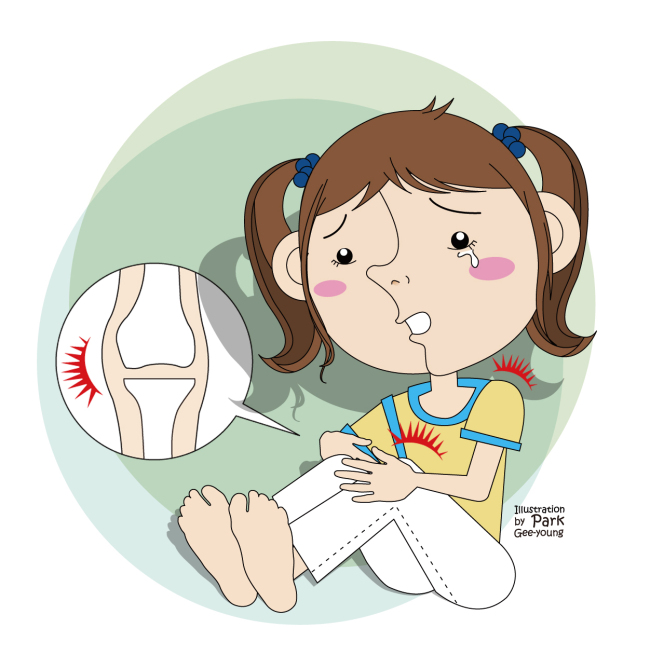
Diseases that are most closely related to pediatric osteosarcoma include retinoblastoma, which is a malignant tumor that occurs in the retina in children. For bilateral retinoblastoma, which is genetically caused, the chance of developing osteosarcoma is 500 times that of healthy people. These can be frequently diagnosed during the work-up after trauma to the affected area, often in teenagers who are physically active, which may explain the relatively high incidence of osteosarcoma in teenagers. Trauma itself is not a cause of osteosarcoma.
Osteosarcoma is most common in mid-teenage boys, and occurs at a younger age in females, who reach their growth spurt before boys. Based on these facts, it is believed to be associated with rapid bone growth. It can arise in all bones, but the most commonly affected areas are around the knee joint, and the arm near the shoulder. The most common symptom is pain in the bones. Pain often occurs following vigorous activities or after trauma. These patients often have had the pain for 2-4 months before diagnosis. The pain is constant and tends to worsen over time. The patient may have a limp due to the pain when bearing weight. However, in the early stages, the tumor cannot be palpated and may not even show up on X-ray images.
If the pain is in a recently traumatized area, the diagnosis can be delayed because the pain is attributed to the trauma. Unless the force was significant, for instance, enough to cause a fracture, most pain due to trauma will get better with time. However, if the pain worsens over the next few weeks, osteosarcoma may be suspected.
If the patient has normal body temperature, but the tender area is warm, swollen and has a larger diameter than the other side, this means that the tumor is significantly enlarged. The area with the tumor is brittle, which can cause fractures and acute pain.
For diagnosis, plain X-rays, bone scans and MRIs are all necessary. The diagnosis is confirmed through a biopsy of the lesion. Another important test is a chest CT scan. This is because metastases from the bone are most common in the lungs. Plain X-rays of the chest may not show small lesions, so a chest CT is necessary to rule out metastases. However, about 80 percent of patients have micrometastases that are invisible on CT images.
In the past, the main treatment for osteosarcoma was amputation of the affected limb to prevent recurrences. Since the 1970s, chemotherapy has been introduced. More recently, the main treatment has been chemotherapy before and after surgery. The surgery is conservative, often preserving the limbs and only removing the tumors.
Radiotherapy is not effective for treating osteosarcoma, and is often associated with side effects, which is why it is not used in most cases. Chemotherapy before surgery can reduce the tumor load, and cause necrosis of surrounding infiltrating cancer cells to reduce the surgical area. This allows removal of the tumor while preserving the limbs. Most patients will have micrometastases in the lungs at the time of diagnosis. The use of chemotherapy before and after the surgery will also reduce the recurrence of cancer in the lungs.
The treatment of osteosarcoma can take between six months and one year to complete. Patients will be admitted to the hospital for 3-5 days every 3-4 weeks for chemotherapy. During the admission every three weeks, the patient will receive outpatient treatment for one week.
Before the introduction of chemotherapy in the late 1970s, the prognosis of osteosarcoma was poor. Even after radical treatment such as amputation, 80 percent of patients died within two years. The most common cause of death was lung metastases. However, with the introduction of chemotherapy and improved surgical technology, approximately 70 percent of patients can achieve complete remission.
Approximately 15 percent of patients have lung lesions that can be seen at the time of diagnosis, and these patients have a poorer prognosis. Any lung metastases should be removed at the time of the operation. Remission can be expected in 20-30 percent of patients with lung metastases. Patients can also be diagnosed with lung metastases after they have already started the treatment, or have completed treatment. If the lesion is smaller than 3 cm, and it is surgically respectable, 40 percent of patients can achieve remission.
Some patients may develop repeated lung metastases. This has a poorer outcome, but unless the cancer is inoperable, repeated surgeries can lead to prolonged survival. Therefore, it is important not to give up even in difficult situations.

By Lee Soo-hyun
The author is a doctor in the Department of Pediatry at Samsung Medical Center and a professor at Sungkyunkwan University School of Medicine. ― Ed.
The author is a doctor in the Department of Pediatry at Samsung Medical Center and a professor at Sungkyunkwan University School of Medicine. ― Ed.
-
Articles by Korea Herald







![[Hello India] Hyundai Motor vows to boost 'clean mobility' in India](http://res.heraldm.com/phpwas/restmb_idxmake.php?idx=644&simg=/content/image/2024/04/25/20240425050672_0.jpg&u=)










